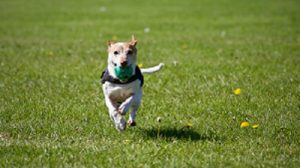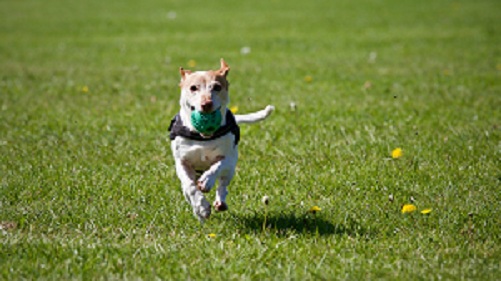
Osteoarthritis (OA) can be a challenging condition for dogs, affecting them irrespective of their age, breed, or size. Nearly 40% of our beloved canine companions grapple with this chronic pain issue, necessitating proactive measures for their overall well-being.
Apart from medical interventions, a dog physical therapy exercises regimen can significantly contribute to managing OA pain, improving joint mobility, and ensuring a fulfilling life for your furry friend.
Guided by the principles advocated by Canine Arthritis Resources and Education (CARE), here are some gentle exercises tailored to suit dogs dealing with osteoarthritis:
Canine physiotherapy exercises
- Basic Commands as Building Blocks:
Basic commands such as sit, stay, and shake serve as the cornerstone for effective canine exercise routines. By instilling these fundamental instructions, owners establish clear communication channels with their dogs, fostering a cooperative and responsive attitude during therapeutic exercises.
These commands not only facilitate better control over the dog’s movements but also create a sense of trust and understanding between the owner and the pet.
This foundational training sets the stage for more advanced activities, ensuring smoother transitions and enhanced engagement throughout the exercise regimen. In essence, mastering these basic commands forms the bedrock upon which a successful exercise program for dogs can be built.
- Slow and Steady Wins the Race:
“Slow and Steady Wins the Race: Begin exercise routines gently to avoid placing unnecessary strain on your dog’s body. By starting at a leisurely pace, you allow your canine companion to acclimate gradually, minimizing the risk of aggravating their condition.
This approach is vital, particularly for dogs dealing with osteoarthritis or other joint-related issues. Rushing into rigorous activities can lead to discomfort or injury.
Taking it slow not only ensures your dog’s physical well-being but also promotes a positive experience, encouraging them to engage willingly in future exercises. Patience in the initial stages sets the foundation for a sustainable and effective exercise regimen.”
- Focus on Correct Form:
“Focus on Correct Form: It’s imperative to ensure that your dog maintains proper form throughout exercise sessions to prevent any inadvertent strain or injury. Just like humans, correct posture is crucial for dogs during workouts.
This involves observing their body alignment and movements closely. Proper form ensures that the right muscles are engaged and reduces the risk of overloading joints or causing discomfort.
By emphasizing correct form, you promote effective and safe workouts for your furry friend, enhancing the benefits of the exercises while minimizing the potential for injury or strain.”
- Listen to Your Dog’s Body:
“Listen to Your Dog’s Body: Observe subtle cues of fatigue such as panting, slowing down, or reluctance to continue. After exercise, watch for signs of discomfort like limping or stiffness.
Permit breaks whenever your dog signals tiredness to avoid overexertion and potential injury. Understanding your pet’s limits fosters a healthy exercise routine, ensuring they enjoy physical activity without strain.
By being attuned to your dog’s needs, you cultivate a supportive environment where they can thrive and maintain optimal well-being.”
Physical Training Tool for Senior Dogs
- Gradual Progression is Key:
Gradual progression in your dog’s exercise routine is essential for long-term success.
As your furry companion becomes more comfortable with the exercises, incrementally increase various factors such as the duration of each session, the distance covered, the intensity of the workout, the number of repetitions, or the frequency of exercise sessions.
By slowly ramping up these elements, you allow your dog’s body to adapt and strengthen over time, reducing the risk of injury or strain.
This method promotes safe and sustainable improvement in your dog’s fitness level and overall well-being, ensuring they can continue enjoying physical activity without undue stress or discomfort.
- Prevent Soreness:
“Prevent Soreness: It’s important to understand that dogs, like humans, can experience Delayed Onset Muscle Soreness (DOMS). This discomfort can occur after unfamiliar or strenuous activity.
To mitigate the risk of soreness, it’s crucial to start exercises slowly, gradually increasing intensity over time.
By easing your pet into the routine, you provide them with a more comfortable experience and reduce the likelihood of post-exercise discomfort.
Paying attention to your dog’s cues and avoiding abrupt changes in activity level can help prevent unnecessary strain and promote a positive exercise experience.”
Now, let’s explore some specific exercises suitable for dogs with osteoarthritis:
Low-Impact Activities for Joint Health:
- Walking:
Start your dog’s walking regimen with brief strolls, gradually increasing the duration and distance as they build endurance. Focus on flat trails or even surfaces to reduce strain on their joints, ensuring a comfortable and enjoyable experience.
Pay attention to your dog’s cues during walks, such as any signs of discomfort or fatigue, and adjust accordingly. Encourage breaks as needed, allowing them to rest and recuperate.
Remember, consistency is key, so aim for regular walks to maintain joint health and overall well-being. By starting slowly and progressing gradually, you can help your dog develop strength and stamina while minimizing the risk of injury.
- Swimming:
Swimming harnesses the natural buoyancy of water, offering a therapeutic solution for dogs with joint issues. As they glide through the water, the resistance provides a gentle yet effective workout, reducing strain on their joints.
This low-impact activity not only alleviates joint pressure but also strengthens muscles, improves endurance, and enhances overall joint mobility.
With each stroke, dogs engage various muscle groups, promoting flexibility and coordination.
Additionally, the water’s supportive properties enable dogs to exercise with less discomfort, making swimming an ideal choice for enhancing their physical well-being while minimizing the risk of exacerbating existing conditions.
- Range of Motion Exercises:
“Range of Motion Exercises: Encourage fluid movement in your dog’s joints by gently guiding them through their complete range of motion. This includes flexing and extending each joint, such as the shoulders, elbows, hips, and knees, in a controlled manner.
These exercises help improve flexibility, increase joint lubrication, and enhance overall mobility. By regularly engaging in range of motion exercises, you can alleviate stiffness, reduce the risk of joint contractures, and promote better joint health for your furry companion.
Remember to start slowly and gently, allowing your dog to adjust comfortably to each movement.”
- Stretching:
Stretching is vital for maintaining joint flexibility and reducing stiffness in dogs with osteoarthritis.
Focus on gentle stretching of specific muscle groups surrounding affected joints, particularly targeting the hips and knees. Gently extending these muscles helps alleviate tension and enhances the range of motion, allowing for smoother and more comfortable movement.
By incorporating regular stretching exercises into your dog’s routine, you can promote joint health and improve overall mobility, contributing to a better quality of life for your furry companion.
- Treadmill Workouts:
“Treadmill workouts offer a controlled environment for dogs struggling with walking, providing a low-impact alternative to traditional outdoor activities. With careful supervision and safety measures, such as adjusting speed and incline, owners can tailor the workout to their dog’s abilities.
This controlled setting allows for gradual progression, ensuring that the exercise remains safe and effective. Additionally, using a treadmill allows for consistent monitoring of the dog’s gait and posture, aiding in the prevention of any potential injuries.
Ultimately, treadmill workouts can be an invaluable tool in helping dogs build strength, improve mobility, and maintain overall fitness levels.”
- Indoor Games and Activities:
Entertain your dog indoors with a variety of interactive toys, puzzles, and games customized to their mobility capabilities. Choose toys that encourage mental stimulation and physical activity, such as treat-dispensing puzzles or tug-of-war ropes.
Rotate different activities to prevent boredom and maintain engagement. While enjoying these games, be vigilant for any indications of fatigue or discomfort, such as excessive panting, reluctance to participate, or limping.
If you notice any signs of distress, immediately cease the activity and allow your dog to rest. Ensuring their comfort and safety during playtime is essential for their overall well-being and enjoyment.
Indoor and Outdoor Rubber Dog Toy
It’s important to remember that these exercises should be adapted to suit your dog’s individual needs and comfort levels. Consulting your veterinarian is crucial for devising a personalized exercise plan that caters to your dog’s specific requirements and the severity of their osteoarthritis. Additionally, seeking guidance from a veterinary rehab or pain specialist can provide further insight into effective physical therapy techniques.
Conclusion
by collaborating with your veterinarian and incorporating a safe and effective exercise routine into your dog’s daily life, you can significantly enhance their quality of life despite osteoarthritis. Alongside pain management strategies, weight control, and environmental adjustments, these exercises empower your canine companion to thrive, transforming the challenge of osteoarthritis into an opportunity for optimal well-being.
Further Reading:
Fitness Buddies: Exercising With Your Dog Slideshow
The Health and Mood-Boosting Benefits of Pets
Top 7 exercises to keep your dog healthy and happy
10 Ways To Celebrate Pet Wellness Month Year-Round
FAQs:
How do you love and care for animals?
To love and care for animals, I prioritize their physical and emotional well-being by providing proper nutrition, regular exercise, and affectionate companionship.
I ensure they have a safe and comfortable environment tailored to their needs, whether indoors or outdoors. Regular veterinary check-ups and prompt medical attention are crucial for their health.
Additionally, I advocate for their welfare by supporting animal shelters, adoption programs, and conservation efforts. Understanding their behaviors and communicating effectively builds trust and strengthens our bond, fostering a fulfilling relationship based on mutual respect and care.
Do dogs get stronger with exercise?
Yes, dogs can become stronger with regular exercise. Just like humans, consistent physical activity helps build muscle mass and improve overall strength in dogs. Engaging in activities like walking, running, swimming, and playing fetch can enhance muscle tone and endurance.
However, it’s essential to ensure that exercises are tailored to your dog’s breed, age, and physical condition to prevent overexertion or injury. Additionally, providing a balanced diet and adequate rest are crucial factors in supporting your dog’s strength-building efforts.
What exercises can you do with your dog at home?
At home, you can engage your dog in various exercises such as indoor fetch, tug-of-war, obedience training sessions, agility drills using household items, interactive toy play, and staircase workouts.
These activities provide mental stimulation, promote bonding, and help maintain your dog’s physical health. Always ensure the exercises are appropriate for your dog’s age, breed, and fitness level to prevent injury and promote enjoyment.
Can you workout with a dog?
Yes, you can definitely work out with your dog! Incorporating your pet into your exercise routine can be enjoyable and beneficial for both of you. Activities like jogging, hiking, or playing fetch in the park can provide excellent cardiovascular workouts for both you and your furry friend. Additionally, dog-friendly workout classes or sports such as agility training can be a fun way to bond while staying active. Just ensure to consider your dog’s fitness level and any specific needs or limitations they may have before starting any new exercise regimen.
